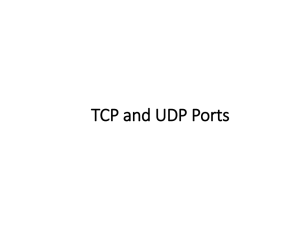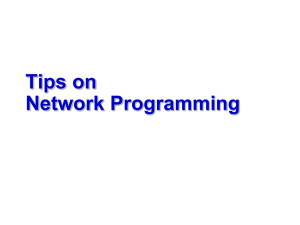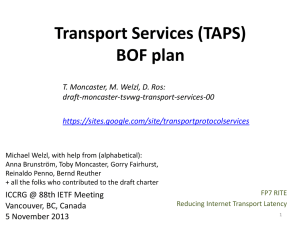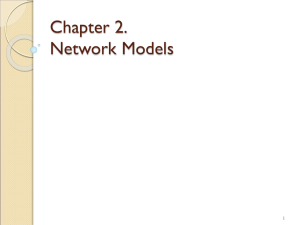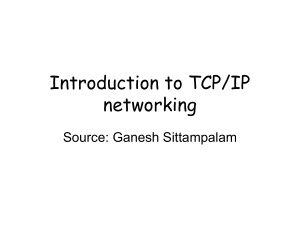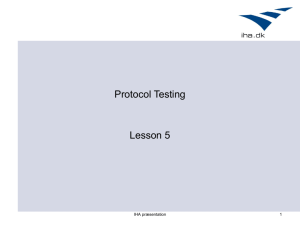Application Design based on TCP or UDP
advertisement
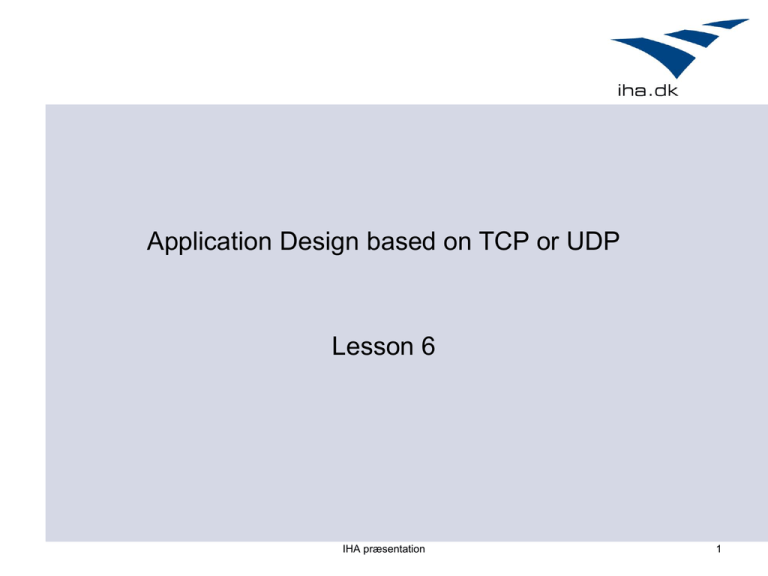
Application Design based on TCP or UDP Lesson 6 IHA præsentation 1 Outline for today • The Internet Protocols: UDP & TCP • Socket programming • Application Design based on TCP/UPD IHA præsentation 2 TCP/UPD: Transport services •provide logical communication between app processes running on different hosts •transport protocols run in end systems •send side: breaks app messages into segments, passes to network layer •rcv side: reassembles segments into messages, passes to app layer •more than one transport protocol available to apps •Internet: TCP and UDP IHA præsentation application transport network data link physical application transport network data link physical 3 Transport vs. network layer •network layer: logical communication between hosts •transport layer: logical communication between processes •relies on, enhances, network layer services IHA præsentation 4 Internet transport-layer protocols •reliable, in-order delivery: TCP •Connection-oriented • Handshake to setup com. •congestion control •flow control •connection setup •unreliable, unordered delivery: UDP •connectionless •no-frills extension of “best-effort” IP •services not available: application transport network data link physical network data link physical network data link physical network data link physicalnetwork network data link physical data link physical network data link physical application transport network data link physical •delay guarantees •bandwidth guarantees IHA præsentation 5 UDP: more •often used for streaming multimedia apps Length, in •loss tolerant bytes of UDP •rate sensitive segment, •other UDP uses •DNS •SNMP •reliable transfer over UDP: add reliability at application layer •application-specific error recovery! 32 bits source port # dest port # length checksum including header Application data (message) UDP segment format IHA præsentation 6 UDP checksum Goal: detect “errors” (e.g., flipped bits) in transmitted segment Sender: Receiver: •treat segment contents as sequence of 16-bit integers •checksum: addition (1’s complement sum) of segment contents •sender puts checksum value into UDP checksum field •compute checksum of received segment •check if computed checksum equals checksum field value: •NO - error detected •YES - no error detected. But maybe errors nonetheless? IHA præsentation 7 TCP: Overview RFCs: 793, 1122, 1323, 2018, 2581 •point-to-point: •full duplex data: •one sender, one receiver •bi-directional data flow in same connection •MSS: maximum segment size •reliable, in-order byte steam: •no “message boundaries” •pipelined: •connection-oriented: •TCP congestion and flow control set window size •handshaking (exchange of control msgs) init’s sender, receiver state before data exchange •send & receive buffers •flow controlled: socket door application writes data application reads data TCP send buffer TCP receive buffer socket door •sender will not overwhelm receiver segment IHA præsentation 8 TCP segment structure URG: urgent data (generally not used) ACK: ACK # valid PSH: push data now (generally not used) RST, SYN, FIN: connection estab (setup, teardown commands) Internet checksum (as in UDP) 32 bits source port # dest port # sequence number acknowledgement number head not UA P R S F len used checksum Receive window Urg data pnter Options (variable length) counting by bytes of data (not segments!) # bytes rcvr willing to accept application data (variable length) IHA præsentation 9 TCP seq. #’s and ACKs Seq. #’s: •byte stream “number” of first byte in segment’s data ACKs: •seq # of next byte expected from other side •cumulative ACK Q: how receiver handles out-of-order segments •A: TCP spec doesn’t say, - up to implementor Host A User types ‘C’ Host B host ACKs receipt of ‘C’, echoes back ‘C’ host ACKs receipt of echoed ‘C’ simple telnet scenario IHA præsentation time 10 Question Suppose you want to do a transaction from a remote client to a server as fast as possible. Would you use UDP or TCP? Why ? You would use UDP. With UDP, the transaction can be completed in one roundtrip time (RTT) - the client sends the transaction request into a UDP socket, and the server sends the reply back to the client's UDP socket. With TCP, a minimum of two RTTs are needed - one to set-up the TCP connection, and another for the client to send the request, and for the server to send back the reply. IHA præsentation 11 Socket Programming IHA præsentation 12 Socket programming Goal: learn how to build client/server application that communicate using sockets socket Socket API • • • • introduced in BSD4.1 UNIX, 1981 explicitly created, used, released by apps client/server paradigm two types of transport service via socket API: • unreliable datagram • reliable, byte streamoriented IHA præsentation a host-local, application-created, OS-controlled interface (a “door”) into which application process can both send and receive messages to/from another application process 13 Socket-programming using TCP Socket: a door between application process and end-end-transport protocol (UCP or TCP) TCP service: reliable transfer of bytes from one process to another controlled by application developer controlled by operating system process process socket TCP with buffers, variables internet socket TCP with buffers, variables controlled by application developer controlled by operating system host or server host or server IHA præsentation 14 Addressing processes •to receive messages, process must have identifier •host device has unique 32-bit IP address •Q: does IP address of host suffice for identifying the process? IHA præsentation 15 Addressing processes •to receive messages, process must have identifier •host device has unique 32-bit IP address •Q: does IP address of host on which process runs suffice for identifying the process? •A: No, many processes can be running on same host •identifier includes both IP address and port numbers associated with process on host. •Example port numbers: •HTTP server: 80 •Mail server: 25 •to send HTTP message to gaia.cs.umass.edu web server: IHA præsentation •IP address: 128.119.245.12 •Port number: 80 16 Socket programming with TCP Client must contact server •server process must first be running •server must have created socket (door) that welcomes client’s contact Client contacts server by: •creating client-local TCP socket •specifying IP address, port number of server process •When client creates socket: client TCP establishes connection to server TCP •When contacted by client, server TCP creates new socket for server process to communicate with client •allows server to talk with multiple clients •source port numbers used to distinguish clients (more in Chap 3) application viewpoint TCP provides reliable, in-order transfer of bytes (“pipe”) between client and server IHA præsentation 17 Client/server socket interaction: TCP Server (running on hostid) Client create socket, port=x, for incoming request: welcomeSocket = ServerSocket() TCP wait for incoming connection request connection connectionSocket = welcomeSocket.accept() setup create socket, connect to hostid, port=x clientSocket = Socket() send request using clientSocket read request from connectionSocket write reply to connectionSocket read reply from clientSocket close connectionSocket close clientSocket IHA præsentation 18 Socket programming with UDP UDP: no “connection” between client and server •no handshaking •sender explicitly attaches IP application viewpoint address and port of destination UDP provides unreliable transfer to each packet of groups of bytes (“datagrams”) •server must extract IP address, between client and server port of sender from received packet UDP: transmitted data may be received out of order, or lost IHA præsentation 19 Client/server socket interaction: UDP Server (running on hostid) Client create socket, clientSocket = DatagramSocket() create socket, port= x. serverSocket = DatagramSocket() Create datagram with server IP and port=x; send datagram via clientSocket read datagram from serverSocket write reply to serverSocket specifying client address, port number read datagram from clientSocket close clientSocket IHA præsentation 20 Application Design based on TCP or UDP IHA præsentation 21 Application Design • Application Architecure to choose? • Client-Server architecture • Peer-to- peer architecture • Hybrid of client-server and P2P • What services do the application requires? • TCP • UDP IHA præsentation 22 Client-server architecture server: •always-on host •permanent IP address •server farms for scaling clients: •communicate with server •may be intermittently connected •may have dynamic IP addresses •do not communicate directly with each other client/server IHA præsentation 23 Pure P2P architecture •no always-on server •arbitrary end systems directly communicate peer-peer •peers are intermittently connected and change IP addresses Highly scalable but difficult to manage IHA præsentation 24 Hybrid of client-server and P2P Skype • voice-over-IP P2P application • centralized server: finding address of remote party: • client-client connection: direct (not through server) Instant messaging • chatting between two users is P2P • centralized service: client presence detection/location • user registers its IP address with central server when it comes online • user contacts central server to find IP addresses of buddies IHA præsentation 25 Application Design • Application Designers should be aware of: • Silly Window Syndrome • IHA præsentation 26 Silly Window Syndrome • Problem • Sender only creates data slowly, or • Receiver consumes data slowly. • Example • Packet size 5 – 10 bytes + 20 bytes (TCP Hdr) + 20 IP Hdr => total of 45-50 bytes • Network capacity used ineffeciently • => adds to congestion in the network IHA præsentation 27 Syndrome created by the sender Nagle’s Algorithm 1. The sending TCP sends the first piece of data it receives from the sending application even if it is only 1 byte 2. After sending the first segment, the sending TCP accumelates data in the output buffer and waits until either the receiving TCP sends ACK or until enough data has accumelated to fill a maximum-size segment. At this time the sending TCP can send a segment 3. Step 2 is repeated for the rest of the transmission IHA præsentation 28 Syndrome created by the sender Nagle’s Algorithm Effect • If sending application is faster than network: • Transmission buffer becomes full => • Segments are larger (maximum-size segments) • If network is faster than sending application: • ACKs received before buffer is full => • Segments are smaller How to enable Nagle’s Algorithm: Socket option: TCP_NODELAY IHA præsentation 29 Syndrome created by the receiver 1. 2. 3. 4. 5. 6. 7. 8. 9. Sender creates data in blocks of 1kbyte Receiver consumes data 1 byte at a time Receiver buffer is 4 kbytes Sender sends 4 kbytes of data Receiver advertises a window size of zero Sender stops sending data Receiving application reads 1 byte Receiving TCP announces a window size of 1 byte Sending TCP sends 1 byte of data Inefficient usage of network IHA præsentation 30 Syndrome created by the receiver Clark’s Solution Send ACK as soon as the data arrives, but Announce a window size of zero until either there is enough space to accommodate a segment of max. Size or until half of the buffer is empty Delayed Acknowledgement Delay sending ACK. The receiver waits until there is a decent amount of space in its incoming buffer before acknowledging the arrived segments. => Sender can not slid its window, and stops sending data. What happens if we wait to long before sending ACK? IHA præsentation 31 Question & repetition IHA præsentation 32 Eksamen er uden forberedelse Eksamensspørgsmål udleveres IHA præsentation 33





